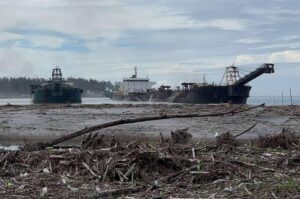Photo courtesy of Zambales Ecological Network
By Diego Morra
Mamamayang Liberal Partylist Rep. Leila de Lima may be aghast at the gall of the China Harbour Engineering Co. Ltd. (CHEC) in dredging San Felipe, Zambales, barely 50 meters from the shore. This is the same Chinese state-owned company that supplied the materials to artificial islands in the contested reefs, sand bars and cays in the South China Sea. She should not stop at investigating CHEC and start the ball rolling for an inquiry into reclamation projects in Manila Bay, where the dredged materials are used.
This company, which is supposedly blacklisted by the International Monetary Fund-World Bank (IMF-WB) for corporate abuses and destruction of marine environments, has been making hay in the Philippines and is engaged in a reclamation project covering hundreds of hectares in Manila Bay in collaboration with a company owned by a Chinese-Filipino political dynasty. It is as notorious as the Chinese companies engaged in building the Kaliwa Dam straddling Rizal; and Quezon that never secured the free, prior informed consent (FPIC) of the afftected Dumagat and Remontado communities.
Zambales residents had for many years also complained about the flattering of mountains in the province, with the material recovered shipped out to the South China Sea. The result is a string of man-made islands that now serve as naval and air force bases of China’s People’s Liberation Army (PLA.) Zambales officials who allowed the environmental mayhem to continue unimpeded were never haled to court for the wanton destruction in exchange for filthy lucre. Helping the Chinese build forward bases in the Spratlys subverts our national security.
Rep. de Lima deserves support inn her quest to put CHEC’s feet to the fire. In fact, the Chinese have never bothered to respect Philippine laws, preferring to engage in seabed quarrying in Batangas right smack at a protected seascape. Other companies are also working quarrying contracts for the benefit of Ramon Ang’s Aerotropolis and covering 2,500 hectares of offshore areas in three Cavite towns. The reclamation of 2,500 hectares of land in Bulakan, Bulacan to host Ang’s airport-cum-port-cum racing circuit called Aerotropolis is conveniently described by Danding Cojuangco’s fair-haired boy as “land development,” only that the area he is reclaiming is comprised of wetlands and mangrove forests that impede storm surges and protect fish habitat. The much-touted planting of mangrove in the area was also stopped by the Department of Environment and Natural Resources (DENR) since they stuck inappropriate species in their version of a mangrove forest.
Taking the cudgels for the people of Zambales, de Lima wants a deeper investigation into CHEC. “This requires an urgent probe. We intend to file a measure to look into these alleged large-scale dredging operations that cause serious environmental destruction, threaten livelihoods, and endanger the safety of our countrymen,” she says. “There is a need to determine the legality and scope of these operations, as well as their impact on the environment and the risks they pose to our coastal communities,” she added. CHEC is a major state owned company under the China Communications Construction Co.
“This Chinese infrastructure firm has already been reported to have a shady track record and to be involved in labor-related complaints—all the more reason for Malacañang to look into the situation in Zambales, as well as in other areas of the country facing similar issues,” de Lima added. In May 2024, the people of San Felipe wondered who permitted at least 14 dredging vessels with Chinese crew members near to scoop up seabed materials in Barangay Sindol and Sitio Laoag in Barangay Maloma. The Philippine Coast Guard detained the crews of at least 17 vessels involved in dredging and reportedly checked whether they violated the government’s environmental protection, safety and security protocols.
De Lima is not alone in complaining about dredging and reclamation projects. One veteran editor also lashed out at one such project at the Laguna de Bay, with a lakeshore area reclaimed and used by a local corporation. This is tragic since the entire 94,900-hectare lake has an average depth of only 2.5 meters and the last time we checked, lakes are not supposed to be reclaimed. The lake is too shallow and too polluted to be a source of potable water. Yet, there is still a chance that some wise guys might propose the idea of really reclaiming the prehistoric caldera for townships, business districts, commercial centers and other megalithic structures. At 94,900 hectares, Laguna de Bay would be the biggest inland reclamation project in the entire planet.
To make Ramon Ang even happier, those who want to make the economy look robust could even look into the possibility of kicking out the entire Ninoy Aquino International Airport (NAIA) and selling the whole hog to any topnotch developer except Manny Villar. Once this is accomplished, the justification for Ang’s New Manila International Airport (NMIA) would materialize, never mind if the Japan International Cooperation Agency (JICA) recommended that the airport be transferred to Sangley Point in Cavite and not to Taliptip, Bulakan, Bulacan.




